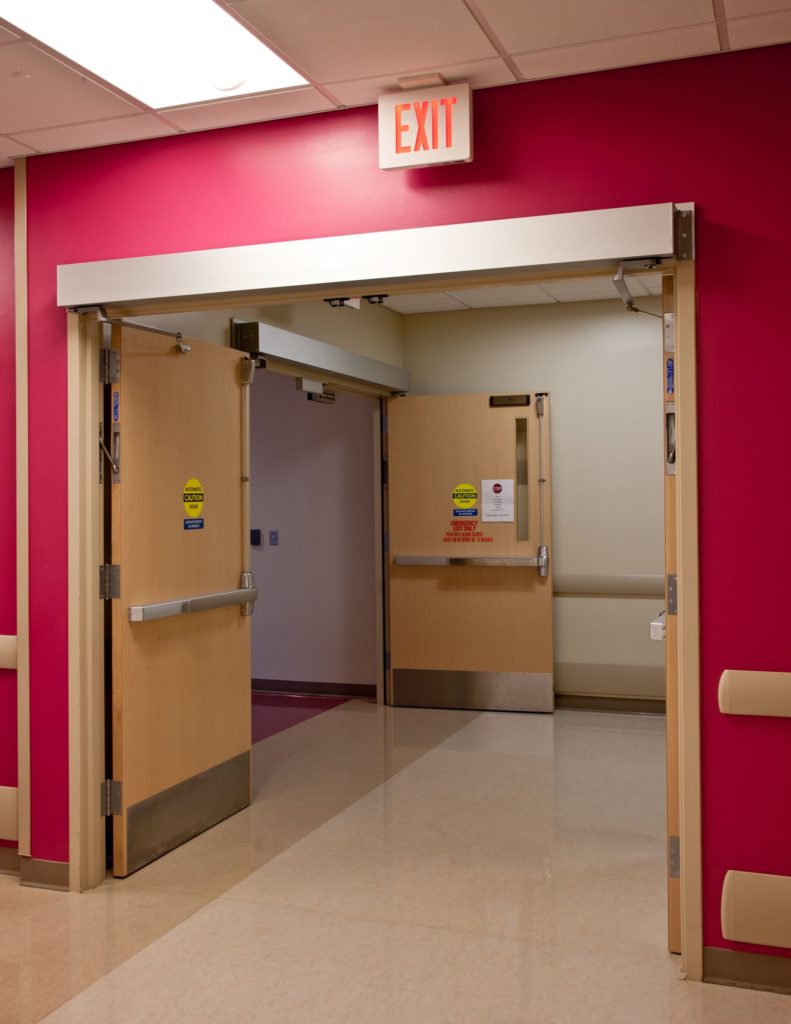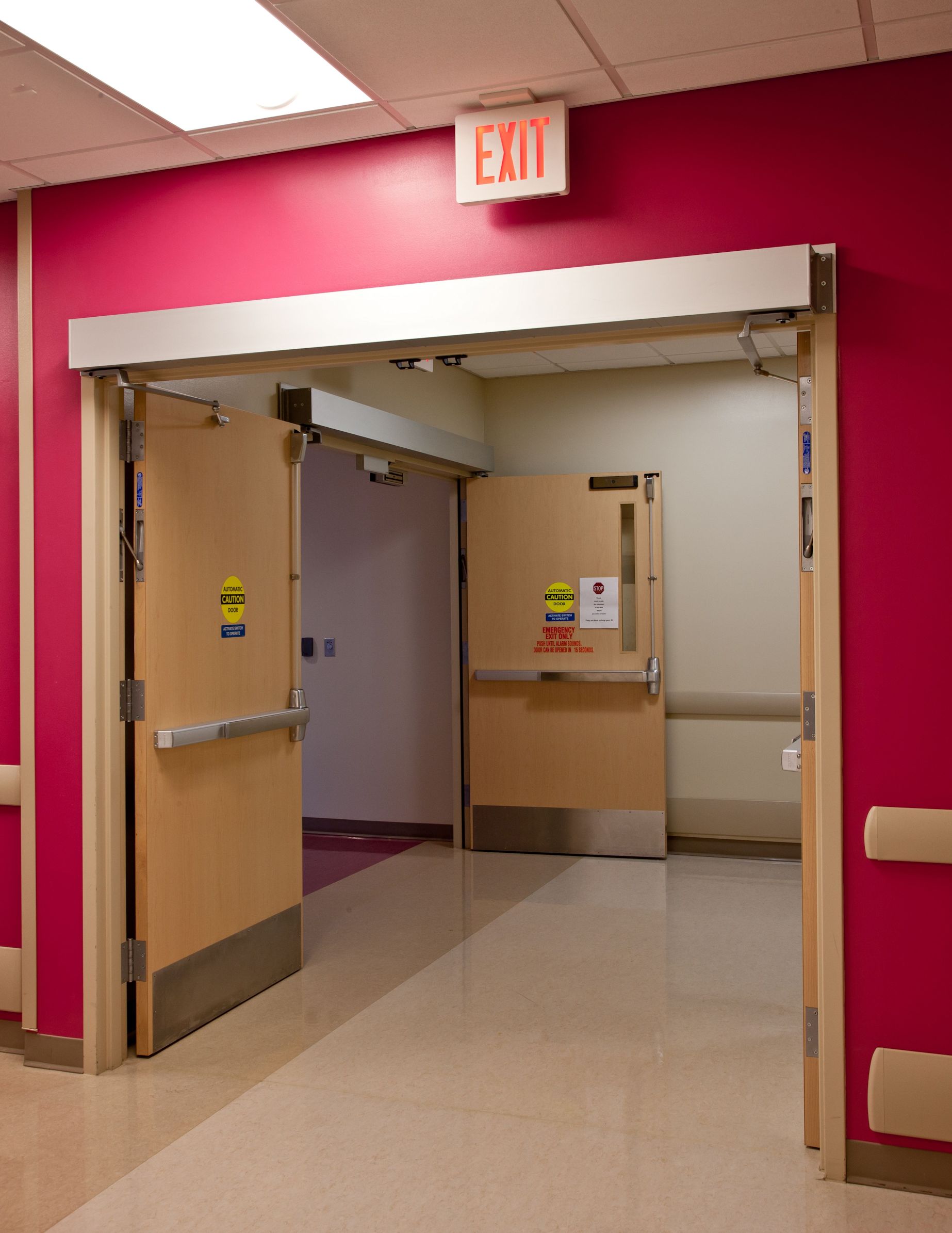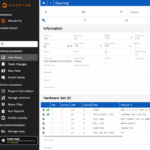Thanks for your patience…my inbox barometer (indicator of how far under water I am) currently stands at 411 emails. I will respond asap!
~~~
 If a door on an accessible route has a vision light or sidelight* that permits viewing, the accessibility standards require the bottom of at least one light to be no more than 43 inches above the floor. This ensures that someone using a wheelchair can see through the glass.
If a door on an accessible route has a vision light or sidelight* that permits viewing, the accessibility standards require the bottom of at least one light to be no more than 43 inches above the floor. This ensures that someone using a wheelchair can see through the glass.
There is an exception for vision lights above 66 inches – like the small lights that are sometimes found at the top of residential doors. Because the lights are used for light transmission and not for viewing, these doors don’t have to comply with the requirement for at least one light to be at the 43-inch location.
Note that this section does not require a door to have a vision light (although there may be mandates in other codes). But if the door has a vision light, this section establishes the required location.
So the question is…
Does the vision light height requirement apply to automatic doors as well as manually-operated doors?
Interesting question – I had never thought about it (have you?). The accessibility standards include two sections related to doors – one called Manual Doors, Doorways, and Manual Gates, and the other called Automatic and Power-Assisted Doors and Gates. The paragraph addressing vision lights is found in the section that covers manual doors. In the section for automatic doors, the ADA standards address the following requirements:
- Clear Width
- Maneuvering Clearance
- Thresholds
- Doors in Series and Gates in Series
- Controls
- Break Out Opening
- Revolving Doors, Revolving Gates, and Turnstiles
The 2017 edition of ICC A117.1 has additional sections for public entrances, vestibules, and door and gate hardware on automatic doors, and does not include a section on revolving doors.
Neither of these standards includes a paragraph in the automatic door section regarding vision lights, so the requirement does not apply to automatic doors. With that said, for safety reasons I think it would make sense for an automatic door to have a vision light at the 43-inch location.
What do you think?
*Fun fact in case you’re searching the PDFs…the 2010 ADA standards call these “vision lights” and “side lights.” ICC A117.1 calls them “vision lites” and “sidelites.”
You need to login or register to bookmark/favorite this content.






Since most of these doors become “manual” on alarm or power failure, I’ve always considered vision panels required.
In all my new door and automatic operator installs I include the appropriate vision lite . This way no one can be blind sided by a auto door. It certainly cannot hurt to err on the side of caution.. if not it could very well hurt .
I would say the lite is required to be within ADA requirements regardless of manual or automatic operation for several reasons.
1. As already mentioned, when the operator fails due to power, or otherwise, it becomes a manual door.
2. The ADA requirement is for visibility to see what is on the other side of the door prior to or while opening it. The presence of an operator, doesn’t “replace” or enhance the visibility.
The trickiest part of this question isn’t the height of the lite, but the operator itself. When power fails, how are the ADA push or pull limits met?
Hi Darrell –
An automatic door is not required to meet the manual door requirements of the accessibility standards when power fails, so the 5-pound opening force limit does not apply to automatic doors. But if the door does not have the required maneuvering clearance for a manual door on the egress side, the operator needs to have backup power.
– Lori
I’ve come across this issue but not for automatic doors. What about doors that have a vision panel for operational purposes, like an overhead dock door? In this case, the vision panel has nothing to do with walking through the door, instead it is used to see which docks have vehicles in them (or for some other similar purpose – I don’t know, I’ve never worked in a warehouse). I would think a wheelchair bound occupant should have just as much right to use this vision panel as a standing person even thought the door itself is not for user passage.
The size, shape, and location of vision panels was originally specified based upon someone walking up and being in very close proximity to the door to be able to look through the vision panel and visually observe if anyone was approaching from the opposite size before manually setting the door in motion. Automatic doors start to operate at approach distances significantly greater than manual operation and what most people can effectively see through the same size vision panel at this greater distance is significantly less than what they can see when they are standing next to the door which questions both the value and need for a vision panel. In many applications the greater distance coupled with the viewing angle thru the vision panel at that distance often fails to reveal a person who may actually be on the other side of the door.